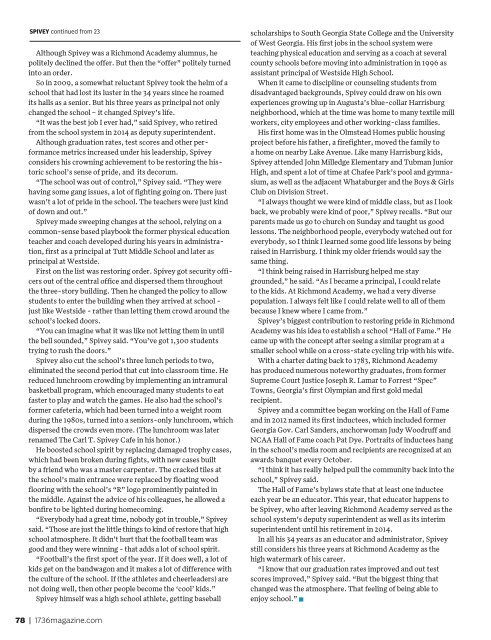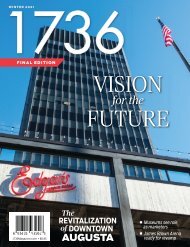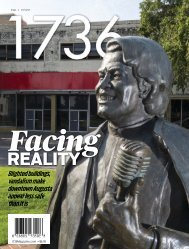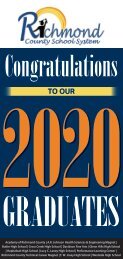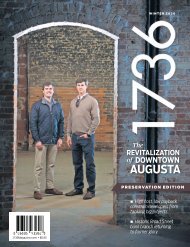Education Edition - 1736 Magazine, Fall 2019
- No tags were found...
Create successful ePaper yourself
Turn your PDF publications into a flip-book with our unique Google optimized e-Paper software.
SPIVEY continued from 23<br />
Although Spivey was a Richmond Academy alumnus, he<br />
politely declined the offer. But then the “offer” politely turned<br />
into an order.<br />
So in 2009, a somewhat reluctant Spivey took the helm of a<br />
school that had lost its luster in the 34 years since he roamed<br />
its halls as a senior. But his three years as principal not only<br />
changed the school – it changed Spivey’s life.<br />
“It was the best job I ever had,” said Spivey, who retired<br />
from the school system in 2014 as deputy superintendent.<br />
Although graduation rates, test scores and other performance<br />
metrics increased under his leadership, Spivey<br />
considers his crowning achievement to be restoring the historic<br />
school’s sense of pride, and its decorum.<br />
“The school was out of control,” Spivey said. “They were<br />
having some gang issues, a lot of fighting going on. There just<br />
wasn’t a lot of pride in the school. The teachers were just kind<br />
of down and out.”<br />
Spivey made sweeping changes at the school, relying on a<br />
common-sense based playbook the former physical education<br />
teacher and coach developed during his years in administration,<br />
first as a principal at Tutt Middle School and later as<br />
principal at Westside.<br />
First on the list was restoring order. Spivey got security officers<br />
out of the central office and dispersed them throughout<br />
the three-story building. Then he changed the policy to allow<br />
students to enter the building when they arrived at school -<br />
just like Westside - rather than letting them crowd around the<br />
school’s locked doors.<br />
“You can imagine what it was like not letting them in until<br />
the bell sounded,” Spivey said. “You’ve got 1,300 students<br />
trying to rush the doors.”<br />
Spivey also cut the school’s three lunch periods to two,<br />
eliminated the second period that cut into classroom time. He<br />
reduced lunchroom crowding by implementing an intramural<br />
basketball program, which encouraged many students to eat<br />
faster to play and watch the games. He also had the school’s<br />
former cafeteria, which had been turned into a weight room<br />
during the 1980s, turned into a seniors-only lunchroom, which<br />
dispersed the crowds even more. (The lunchroom was later<br />
renamed The Carl T. Spivey Cafe in his honor.)<br />
He boosted school spirit by replacing damaged trophy cases,<br />
which had been broken during fights, with new cases built<br />
by a friend who was a master carpenter. The cracked tiles at<br />
the school’s main entrance were replaced by floating wood<br />
flooring with the school’s “R” logo prominently painted in<br />
the middle. Against the advice of his colleagues, he allowed a<br />
bonfire to be lighted during homecoming.<br />
“Everybody had a great time, nobody got in trouble,” Spivey<br />
said. “Those are just the little things to kind of restore that high<br />
school atmosphere. It didn’t hurt that the football team was<br />
good and they were winning - that adds a lot of school spirit.<br />
“Football’s the first sport of the year. If it does well, a lot of<br />
kids get on the bandwagon and it makes a lot of difference with<br />
the culture of the school. If (the athletes and cheerleaders) are<br />
not doing well, then other people become the ‘cool’ kids.”<br />
Spivey himself was a high school athlete, getting baseball<br />
scholarships to South Georgia State College and the University<br />
of West Georgia. His first jobs in the school system were<br />
teaching physical education and serving as a coach at several<br />
county schools before moving into administration in 1996 as<br />
assistant principal of Westside High School.<br />
When it came to discipline or counseling students from<br />
disadvantaged backgrounds, Spivey could draw on his own<br />
experiences growing up in Augusta’s blue-collar Harrisburg<br />
neighborhood, which at the time was home to many textile mill<br />
workers, city employees and other working-class families.<br />
His first home was in the Olmstead Homes public housing<br />
project before his father, a firefighter, moved the family to<br />
a home on nearby Lake Avenue. Like many Harrisburg kids,<br />
Spivey attended John Milledge Elementary and Tubman Junior<br />
High, and spent a lot of time at Chafee Park’s pool and gymnasium,<br />
as well as the adjacent Whataburger and the Boys & Girls<br />
Club on Division Street.<br />
“I always thought we were kind of middle class, but as I look<br />
back, we probably were kind of poor,” Spivey recalls. “But our<br />
parents made us go to church on Sunday and taught us good<br />
lessons. The neighborhood people, everybody watched out for<br />
everybody, so I think I learned some good life lessons by being<br />
raised in Harrisburg. I think my older friends would say the<br />
same thing.<br />
“I think being raised in Harrisburg helped me stay<br />
grounded,” he said. “As I became a principal, I could relate<br />
to the kids. At Richmond Academy, we had a very diverse<br />
population. I always felt like I could relate well to all of them<br />
because I knew where I came from.”<br />
Spivey’s biggest contribution to restoring pride in Richmond<br />
Academy was his idea to establish a school “Hall of Fame.” He<br />
came up with the concept after seeing a similar program at a<br />
smaller school while on a cross-state cycling trip with his wife.<br />
With a charter dating back to 1783, Richmond Academy<br />
has produced numerous noteworthy graduates, from former<br />
Supreme Court Justice Joseph R. Lamar to Forrest “Spec”<br />
Towns, Georgia’s first Olympian and first gold medal<br />
recipient.<br />
Spivey and a committee began working on the Hall of Fame<br />
and in 2012 named its first inductees, which included former<br />
Georgia Gov. Carl Sanders, anchorwoman Judy Woodruff and<br />
NCAA Hall of Fame coach Pat Dye. Portraits of inductees hang<br />
in the school’s media room and recipients are recognized at an<br />
awards banquet every October.<br />
“I think it has really helped pull the community back into the<br />
school,” Spivey said.<br />
The Hall of Fame’s bylaws state that at least one inductee<br />
each year be an educator. This year, that educator happens to<br />
be Spivey, who after leaving Richmond Academy served as the<br />
school system’s deputy superintendent as well as its interim<br />
superintendent until his retirement in 2014.<br />
In all his 34 years as an educator and administrator, Spivey<br />
still considers his three years at Richmond Academy as the<br />
high watermark of his career.<br />
“I know that our graduation rates improved and out test<br />
scores improved,” Spivey said. “But the biggest thing that<br />
changed was the atmosphere. That feeling of being able to<br />
enjoy school.”<br />
78 | <strong>1736</strong>magazine.com<br />
1117_T_78_AM____.indd 78<br />
10/25/<strong>2019</strong> 12:10:01 PM


